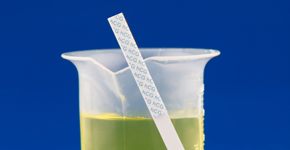Diagnosis Bill Brieger | 02 Nov 2014 09:02 am
Fyodor UMT Researchers at ASTMH
Recently we shared the news that Fyodor Biotechnologies’ new Urine Malaria Test (UMT) has been approved by Nigeria’s food and drug agency. The research team from the University of Lagos and Fyodor will be at the American Society of Tropical Medicine and Hygiene Annual Meeting.
 The poster abstract is outlined below, but please visit the actual poster on Tuesday at #882 Poster Session B starting at noon, to learn more from the researchers and discuss the implications for the future of malaria case management.
The poster abstract is outlined below, but please visit the actual poster on Tuesday at #882 Poster Session B starting at noon, to learn more from the researchers and discuss the implications for the future of malaria case management.
———–>
Effective case management of malaria requires prompt diagnosis and treatment within 24 hours. Despite current policy guidelines that mandate confirmed parasitological diagnosis before treatment, access to diagnostic testing remains low in sub-Saharan Africa.
Today, malaria diagnosis is only by blood-tests (microscopy and rapid diagnostic tests, RDTs), which are invasive, multistep and therefore relatively complex to perform, require technical expertise, and not available in most public and private sector healthcare settings where more than 65% of the population seek care.
 Here, we report the results of a multicenter pivotal clinical trial of Fyodor Urine Malaria Test (UMT) – a simple (one-step, no blood, no reagents, no equipment) dipstick test that detects Plasmodium falciparum parasite proteins shed in the urine of febrile malaria patients. A total of 1,893 participants (?2 years) with fever (axillary temperature ?37.5°C) or history of fever in the last 48 hours were enrolled at 6 primary healthcare centers in rural and suburban communities in Lagos State, Nigeria, over a 7-month period that covered both rainy and dry seasons.
Here, we report the results of a multicenter pivotal clinical trial of Fyodor Urine Malaria Test (UMT) – a simple (one-step, no blood, no reagents, no equipment) dipstick test that detects Plasmodium falciparum parasite proteins shed in the urine of febrile malaria patients. A total of 1,893 participants (?2 years) with fever (axillary temperature ?37.5°C) or history of fever in the last 48 hours were enrolled at 6 primary healthcare centers in rural and suburban communities in Lagos State, Nigeria, over a 7-month period that covered both rainy and dry seasons.
Matched patient urine and fingerprick blood sample were tested using the UMT, Binax NOW (Inverness) (HRP-2/pLDH) test, and microscopy. A total of 358 participants (18.9%) had confirmed malaria by microscopy; Fyodor UMT, 450 (23.8%); Binax NOW (pLDH), 386 (20.4%) and Binax NOW RDT (HRP-2), 731 (38.6%).
Statistical data analyses to determine test performance characteristics are ongoing and will be made available within a month. The UMT has the potential of expanding access to malaria diagnosis especially in settings where blood test is not possible.
Authors: Wellington A. Oyibo, Nnenna Ezeigwe, Godwin Ntadom, William Brieger, Wendy O’Meara, Anne Derrick, Bao Lige, Oladosu Oladipo, Eddy C. Agbo